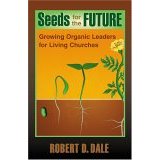Opening this “seed catalog,†as author Bob Dale calls his book on organic church leadership (Seeds for the Future: Growing Organic Leaders for Living Churches. St. Louis, MO: Lake Hickory Resources, 2005), you are struck almost immediately by central themes of growth, cultivation, and numerous agricultural metaphors integral to this work. Dale takes the challenges of congregational leadership and lays out a path that pushes readers to evaluate themselves as church leaders and their church as faith communities.

Dale looks at the entire process of developing leaders in three different sections. In the first, he looks at individuals, the church, and the already-functioning nature of that church. This section encourages leaders to evaluate themselves and where they need to grow. It also pushes leaders to an understanding that churches are living, vibrant congregations that must be understood as they are before change can occur, and that change is already happening. Section 1 is about understanding what is before moving on to what will come.
In Section 2, Dale addresses the concerns of forming the foundations for ministry change: connecting, centering, and challenging. In the chapter looking at connecting within the congregation, Dale considers the importance of communal relationships and the foundation of trust that is needed for change. He also gives practical advice on how to cultivate trust and how to avoid fostering mistrust. Centering is addressed as the need to focus, not on the boundaries of a ministry or congregation, but rather on the central mission that serves as a stackpole for all the other efforts of the church. This involves spiritual growth among individuals and as a church, as well as cultivating discernment. The third aspect of change is the need to challenge the congregation. Dale reminds the reader that this step takes courage, but those times of vision-casting and involvement that are risky can stretch a church in the direction it needs to go.
The final section of Dale’s book focuses on the action piece of cultivating leaders: what he calls harvesting, the techniques and structures and strategies that actually help people move along the journey from pew-filler to congregational leader. As he considers cultivating leadership structures, Dale reminds the reader of the necessity of stability but also flexibility. Either on its own is liable to fail, but if structures are put in place that have a balance, they can thrive. He centers his thoughts of leadership strategies on three things: focus, flexibility, and future. Any strategy that has no focus, does not leave room for flexibility in response to situations that may arise, and is not future-oriented is not likely to succeed. In his final chapter, Dale takes a look at the sort of processes that can be implemented after all of the groundwork has been laid: processes that constantly move and grow and keep leaders revisiting the foundations of leadership while urging them on to growth.
I found Seeds for the Future to be very accessible. Dale incorporated informative subsection titles, coaching conversations that captured each section’s essence, and diagrams that helped the reader grasp the concepts discussed. In addition, he provided short definitions for specialized terms (i.e. “Systems Thinkingâ€) and metaphors (i.e. “icebergâ€) in text boxes on the same page. The case study that he followed throughout the book was informative and illustrative. However, at times the book’s format was fairly “busy,†providing too much sensory input that distracted. Also, the constant use of agricultural metaphors, while providing thematic continuity, at times seemed like a stretch. Overall, though, I believe this book would be a good addition to any pastor or educator’s bookshelf, and it is a book I plan to read again for my own church context.
Reviewed by guest blogger Jonathan Adam Tyler
